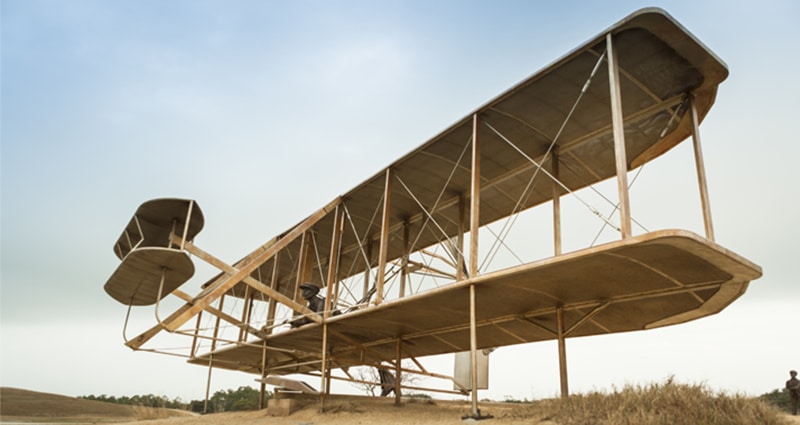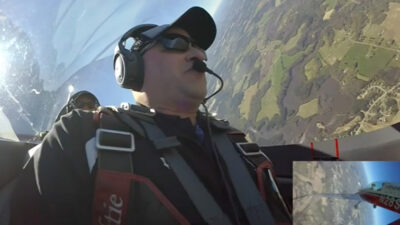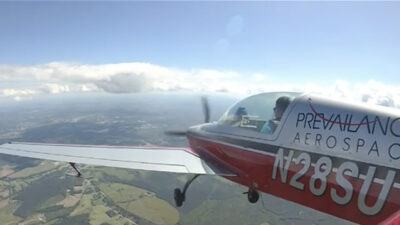Taking on Spins & Stalls – A Brief History

More than 100 years ago, as the Wright brothers experimented with different aircraft designs, they recognized that control of a flying aircraft would be the most crucial and hardest problem to solve.1 During their initial flight tests, the brothers encountered wing stalls in which the lift would suddenly decrease. Their early use of wing warping also introduced them to the effect known as adverse yaw, where when warping one wing to increase lift and the other to decrease it, the higher wing’s drag was also increased causing the aircraft to turn in the opposite direction.
In Wilbur’s correspondence with Octave Chanute, a French-American aviation pioneer, he indicated in 1901 that Orville had “allowed the machine to turn up a little too much and it stalled it.” This was the first reference to the word “stall” in the same context that we use it today.
Thankfully the brothers did not give up, designed an improved wing, and installed a rudder to coordinate the wing warping turn to overcome the adverse yaw problem.1 At that time, the Wright brothers were the most experienced glider pilots in the world and turned that knowledge into four successful powered flights on December 17, 1903.
On-aircraft introduction to spin and recovery
The Advent of Spin-Recovery Training
As the concept of flight exploded in both popularity and use, the knowledge of aircraft control also grew at a rapid pace. The use of opposite rudder to recover from a spin was identified by Lt Wilfred Parke in 1912.2 Despite the discovery of this technique, pilots were not taught spin-recovery procedures until the beginning of World War I where they routinely used spins as an evasive maneuver during combat and to take advantage of fleeting holes in the under cast to descend VFR.
Understanding how important spin training was, in 1926 the Federal Government, using the newly created Air Commerce Act, enacted one of its first Civil Air Regulations (CAR) mandating spin training for all pilot applicants. Unfortunately, this requirement only lasted until 1949 due to mounting pressure from aircraft manufacturers and the high fatality rate associated with stall/spin accidents. The Civil Aeronautics Authority (precursor to the FAA) enacted CAR amendment 20-3 eliminating mandatory spin training.
For the next 30 years the knowledge of spin recovery was passed from instructor to student with no formal hands-on requirement. Pilots received little to no training on how to recover from spins and minimal exposure to stall avoidance. Report No. FAA-RD-77-26 revealed that stall/spin related accidents accounted for approximately one-quarter of all fatal general aviation accidents.
Renewed Interest in Spin-Recovery Procedures
In June of 1980, representatives from all facets of civilian and military aviation met in Washington, DC for hearings on whether mandatory spin training should be reinstated. Chairman Jim Lloyd wrote, “The overwhelming evidence from testimony reveals a whole flight regime…that is kept a mystery to the licensed aviator by the FAA by practice and regulation”. It wasn’t until a decade later in 1991 that AC 61-67B increased stall and spin awareness training for pilot applicants. Unfortunately, it stopped short of requiring on-aircraft spin training for all pilots, and only mandated the training for flight instructors.
Since that time, the FAA, ICAO, EASA, Flight Safety Foundation and many more organizations have looked at different methods of increasing stall and spin awareness, or more specifically, Loss of Control Inflight (LOC-I). Initiatives such as Safer Skies, FAAST, and the Airplane Upset Recovery Training Aid Rev2 were all focused on reducing the fatal accident rate in civil aviation.
Upset Prevention and Recovery Training Today
In 2012, the loss of control avoidance and recovery training (LOCART) initiative revealed existing practices that were found to be a contributory factor to inappropriate responses by flight crews. As an example, one training methodology was based on the pilot being able to achieve recovery with power and minimal altitude loss, vice reducing angle of attack (AOA).3
The release of AC 120-109 in 2012 emphasized the reduction of AOA as the most important response to an unexpected stall or stick pusher event and provided best practices for training and testing. Three years later AC 120-111 was released to address Upset Prevention and Recovery Training (UPRT). This AC focused on recommended practices and guidance for academic and flight simulation training device (FSTD) training to prevent a developing upset condition and ensure correct recovery responses to upsets. Even though the AC was directed at Part 121 air carriers, the guidance for UPRT training is still applicable across the full spectrum of aviation training.
Of course, with the enormous amount of attention given to understanding upsets, stalls and spins, the best method for pilots to truly learn how to recover from these events is an end-to-end training program that includes academics, practice in own aircraft FSTD, and on-aircraft upset training. Only when a maneuver is performed consistently in an actual flight environment can it be considered mastered and responsive to an unexpected upset.
References
1 Overview of Wright Brothers Discoveries, Retrieved on 2/15/2018.
2 Wilfred Parke, Retrieved on 2/15/18.
3 Manual on Aeroplane Upset Prevention and Recovery Training, Retrieved on 2/14/2018.

Prevailance Aerospace is a UPRT provider that has been working with corporate, government, and general aviation pilots to improve safety in the aviation industry. Prevailance Aerospace uses Extra 300 Series Aircraft for training and our pilots are experienced aviation professionals from various military and general aviation backgrounds. We know that successful aviation endeavors are accomplished through an uncompromising commitment to safety, impeccable professionalism, tremendous attention to detail, and constant improvement.
http://prevailanceaerospace.com
© 2025 Prevailance Aerospace. All Rights Reserved.
Next ArticleRelated Posts

Rise Up for the Next Generation
There is no doubt in my mind that flying is the way mankind is meant to travel, yet the continued success and growth of the industry requires a refined approach to safety. As someone who flies commercially and with a new interest in a career in aviation, I want the reassurance that the pilot in command (PIC) and crew are adequately prepared if and when an aircraft ends up in an upset.

Three Considerations That Set Pilots Up for Success
Constantly reviewing aviation accidents and incidents is challenging. As an instructor, it is not only the injuries and fatalities that make it hard, but the sheer magnitude of avoidable aspects of each incident. These safety reports prove that every Pilot in Command (PIC) is accountable for what transpires.

